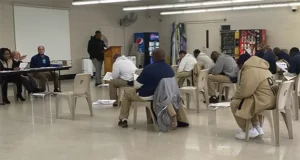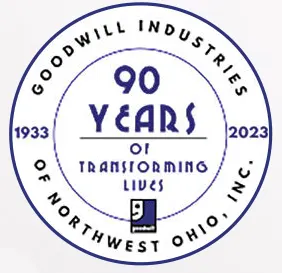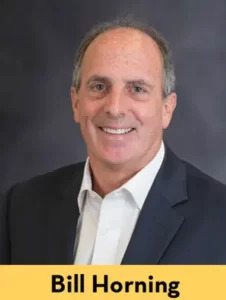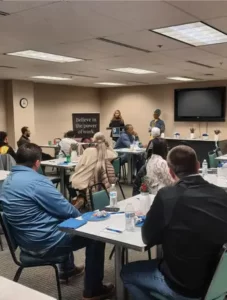Search for the Indispensable Workforce Can Be Found in Returning Citizens
Ohio Programs Preparing Formerly Incarcerated for Careers in Construction
A search engine request of “having one but not the other” produces the answer many heavy/highway construction contractors know: “Indispensable.” And the answer comes to mind probably quicker than the 0.43 seconds it takes Google.
Just as contractors know there is no construction without projects, they are also aware there’s no construction without a workforce.
 Entering 2023 there seems to be no shortage of projects for the heavy/ highway construction industry. However, there is also no shortage of reports about the need for the indispensable worker. Statistics and information outlets show an ongoing workforce problem in the heavy/highway construction industry that continues to stymie the nation’s transportation and utilities improvement efforts (see Workforce Worries, page 16). Construction Executive, in its “Job Sight: The 2023 Construction Economic Forecast,” lists several reasons why the U.S. needs upwards of 650,000 additional people to join the construction industry. The reasons range from a shortage of trained workers, Baby Boomer retirements, shifting technologies, lack of labor force growth and more.
Entering 2023 there seems to be no shortage of projects for the heavy/ highway construction industry. However, there is also no shortage of reports about the need for the indispensable worker. Statistics and information outlets show an ongoing workforce problem in the heavy/highway construction industry that continues to stymie the nation’s transportation and utilities improvement efforts (see Workforce Worries, page 16). Construction Executive, in its “Job Sight: The 2023 Construction Economic Forecast,” lists several reasons why the U.S. needs upwards of 650,000 additional people to join the construction industry. The reasons range from a shortage of trained workers, Baby Boomer retirements, shifting technologies, lack of labor force growth and more.
“We definitely know that so many of the skilled laborers are retiring and leaving the workforce …, “said Eric Slack, director of Mission Services for Goodwill Industries of Northwest Ohio Inc. in Toledo, which operates Stay the Course.
“Everybody is in the same boat; everyone needs employees,” added Bill Horning, founder/president of Reach Success Inc. in Cleveland. “… Skilled workers, that is a major deficiency in society; people are not trained and not skilled in what they need to be.”
Slack and Horning are confident they have an answer to Ohio’s heavy/highway construction industry skilled labor shortage: Hire the state’s readily available trained and skilled returning citizens. With more than 600,000 incarcerated individuals nationally – who will be returning citizens this year – there is a quantity of people who can be trained to become quality construction workers.
According to Equipment World, in an article “Would You Hire a Former Prisoner at Your Construction Business,” research by the American Civil Liberties Union shows “employees with criminal records have higher retention rates than those without, saving employers on hiring costs.” And just as re-entry individuals can help the bottom line of companies, education while imprisoned and employment upon release have shown to “reduce the odds of ex-cons ending up back behind bars.”
“One of the things that I share with employers is that some of the best people to serve as employees are those individuals who have done long sentences …,” Slack said. “Those individuals are great workers because they are loyal, they are used to a routine, they are very timely, they also will come do their job, mind their business and go home … So those are some of the best employees.”
The U.S. has the highest incarceration rate in the world, containing nearly 25% of the world’s prison population. In 2022, nearly 2 million people were being held in U.S. prisons, juvenile correctional and immigration facilities, county jails, military prisons, commitment centers and more. Ohio began 2023 with more than 43,800 people incarcerated at 26 Ohio Department of Rehabilitation & Correction System (ODRC) facilities, as the state is typically among the top-five states for most imprisoned.
With nearly half of Ohio’s incarcerated being released each year, Horning and Slack believe the population of returning citizens provides an abundant supply of would-be skilled workers. It’s also a strategy for having formerly incarcerated stay out of trouble and become positive members in society. While nationally the recidivism rate – or tendency of a convicted criminal to commit another crime – is 68% within the first three years of release, ORDC statistics show Ohio’s three-year recidivism rate is less than half the national mark at 32.7%. Those recidivism rates are much lower for Stay The Course and Reach Success participants.
 The goal of Slack and Horning is to continue to reduce the state’s recidivism rate through their work in Goodwill Industries’ Stay The Course and Reach Success programs, respectively. However, admittedly, one of their first tasks at hand is changing the mindset of employers about looking at returning citizens as potential hires.
The goal of Slack and Horning is to continue to reduce the state’s recidivism rate through their work in Goodwill Industries’ Stay The Course and Reach Success programs, respectively. However, admittedly, one of their first tasks at hand is changing the mindset of employers about looking at returning citizens as potential hires.
Slack recognizes the “skittish” reaction people may have toward hiring the formerly incarcerated, but he believes the idea is becoming more acceptable. “Absolutely, that mindset is still quite prevalent,” he said. “However, those barriers are starting to come down now because one of the things that people are becoming aware of is that returning citizens are everywhere.”
OCA members learned at the 2021 OCA Winter Conference’s seminar, “Challenges & Success Stories in Returning Women & Men to the Workforce,” that three of 10 Ohioans have committed felonies. Horning takes it a step forward, saying, “80% of people in Ohio know someone within their family unit or friends that were incarcerated …”
“Most individuals have a family member directly or indirectly impacted by having a returning citizen,” Slack added. “And I think people are aware that 90% of the people in prison are going to get out. So, we have to come up with some avenues in order to have them come back into society and have places for them.” Goodwill Industries and Reach Success are two organizations not only helping find those avenues but are paving the way for Ohio’s approximately 20,000 returning citizens each year – by providing skills and working with both the potential employee and employer.
Stay The Course
 Celebrating its 90th year in 2023, Goodwill Industries has a history of occupational skills training, as Slack mentioned of the organization’s work with individuals who have minor children and are living in poverty; young adults moving out of children’s services and foster programs; and formerly incarcerated. The latter being Stay The Course, a program begun approximately four years ago when Goodwill earned a competitive federal grant through the Department of Justice. Regarding Stay The Course, Slack said, “It allows us to actually go into the institutions in order to start to do the outreach and training within six months of an individual’s release. Then, after that we try to provide services for them and connect them with all the jobs and training opportunities.”
Celebrating its 90th year in 2023, Goodwill Industries has a history of occupational skills training, as Slack mentioned of the organization’s work with individuals who have minor children and are living in poverty; young adults moving out of children’s services and foster programs; and formerly incarcerated. The latter being Stay The Course, a program begun approximately four years ago when Goodwill earned a competitive federal grant through the Department of Justice. Regarding Stay The Course, Slack said, “It allows us to actually go into the institutions in order to start to do the outreach and training within six months of an individual’s release. Then, after that we try to provide services for them and connect them with all the jobs and training opportunities.”
 Having developed relationships with case workers in the correctional facilities, Goodwill’s Stay the Course includes a one month post-release curriculum for returning citizens. “We start off with soft skills training,” Slack said, “helping them with a resumé, interview techniques, dress for success and character-type development and how to conduct themselves in the workplace.” The program also includes getting the participants trades training through the unions, where they learn carpentry, flooring, machine work and more. “From there, it’s getting them involved with a general contractor,” said Slack, who has been with Goodwill Industries for five years.
Having developed relationships with case workers in the correctional facilities, Goodwill’s Stay the Course includes a one month post-release curriculum for returning citizens. “We start off with soft skills training,” Slack said, “helping them with a resumé, interview techniques, dress for success and character-type development and how to conduct themselves in the workplace.” The program also includes getting the participants trades training through the unions, where they learn carpentry, flooring, machine work and more. “From there, it’s getting them involved with a general contractor,” said Slack, who has been with Goodwill Industries for five years.
Because of Goodwill’s long history and recognition throughout the nation and state – mainly through its 4,200 retail stores in the U.S., including more than 200 in Ohio – Slack said Stay the Course can work with a variety of employers – whether it is in retail, manufacturing, high tech or construction. “… We are able to bring our employees and the employers together, and also we are able to have those conversations with the various employers about what their needs are.”
Stay the Course proved successful when it worked with the Ohio Department of Transportation (ODOT) on a project on Interstate 75 and the Anthony Wayne Trail near Toledo. “ODOT wanted Goodwill Industries to recruit individuals from the neighborhood where the construction project was taking place,” Slack said. Recruiting 35 workers, which included more than 25 returning citizens, Goodwill partnered with construction contractors – including OCA members E.S. Wagner Co. and Kokosing Construction Co. Inc. – and Carpenters Local 351 and Laborers Local 500 to get participants trained. “So, we helped recruit a number of individuals … We got them trained … We got them jobs – and we provided them ‘wraparound services,’ where we purchased work boots, tools, work clothes. And they got good construction jobs working on that I-75 project …,” Slack said. “It was kind of a win-win; we got people from the neighborhood and they were great advocates for us.”
At the conclusion of the ODOT project, a 90-day follow-up of Stay The Course participants showed everyone still employed. This past November, nearly a year after the project, Slack’s employment update was that “most of them are working, and if they are not, they are in contact with the union to try to get them jobs.”
The I-75 project continues the relationship Goodwill Industries has developed with ODOT prior to development of the Stay The Course program. Through Goodwill’s Commercial Services, Slack said, “We will do janitorial cleaning at the different ODOT sites around the state, and we have also trained individuals so that ODOT can hire them for its snowplow and heavy machinery type work.”
Heading into 2023, Stay The Course includes 146 participants, which Slack said are willing and waiting to work in construction. “Obviously, with the whole construction piece it’s been 24-7. If there is a contractor that has that need in the springtime, we marshal all our (training) resources to go in that direction.”
Reach Success
 Reach Success and Horning are all too familiar with the around the-clock commitment to its program’s participants. With the lure of illegally “making $3,000 an hour on the street corner,” Horning believes the best way to combat recidivism is to pair the returning citizen to a career the person would be happy to be in. “The biggest thing we help with is for people to realize career placement instead of job placement … One of our big stalwarts, and what Reach Success is all about, is we run a career passion development program.”
Reach Success and Horning are all too familiar with the around the-clock commitment to its program’s participants. With the lure of illegally “making $3,000 an hour on the street corner,” Horning believes the best way to combat recidivism is to pair the returning citizen to a career the person would be happy to be in. “The biggest thing we help with is for people to realize career placement instead of job placement … One of our big stalwarts, and what Reach Success is all about, is we run a career passion development program.”
A returning citizen himself,” Horning incorporated Reach Success in December 2017. Today, Reach Success has grown from assisting returning citizens to being a community partner that works with youth to 70-year-olds on addressing barriers, educational achievement, career passions and personal growth.
 When it comes with reentry individuals, Horning knows the importance of preparing them for their futures while they are still incarcerated. “Reach Success’ reach in corrections is really huge,” he said of the program that is initiated for participants six to nine months prior to their release from prison. “We basically address 23 barriers we know they’re going to hit coming home and we try to address those barriers before they even walk out the door.” Horning listed the variety of questions incarcerated individuals need to answer upon returning to society: “’Where am I going to work?’ Sometimes it’s: ‘Where am I going to live? Is it a good place to go home to?’ ‘Do I need to find a better place to go home to so I’m not going to get into the same things?’ There are a lot of different aspects that we help people with, child support, getting your license and that kinds of stuff that we work with them inside,” he said of Reach Success. “Then once they come home, our job really starts because we pick them up the day they walk out the door and we continue with them …”
When it comes with reentry individuals, Horning knows the importance of preparing them for their futures while they are still incarcerated. “Reach Success’ reach in corrections is really huge,” he said of the program that is initiated for participants six to nine months prior to their release from prison. “We basically address 23 barriers we know they’re going to hit coming home and we try to address those barriers before they even walk out the door.” Horning listed the variety of questions incarcerated individuals need to answer upon returning to society: “’Where am I going to work?’ Sometimes it’s: ‘Where am I going to live? Is it a good place to go home to?’ ‘Do I need to find a better place to go home to so I’m not going to get into the same things?’ There are a lot of different aspects that we help people with, child support, getting your license and that kinds of stuff that we work with them inside,” he said of Reach Success. “Then once they come home, our job really starts because we pick them up the day they walk out the door and we continue with them …”
Horning said the key to Reach Success is working with the individual to not just find a job but to find a career, as he rhetorically asked: “What would you love to do every day … What would you wake up to at 7 a.m. everyday and can’t wait to do?”
Reach Success has a database of more than 2,000 contacts in businesses, agencies, groups and associations throughout the state. “Working with associations gives us a lot more flexibility to place people in the right area they want to get into,” Horning said. “And then we work with those agencies, and once we get the hand-off, we work with those particular companies that could be a good fit and we see what we need to do to support them on training.” Reach Success works with unions, community colleges and trade schools to get participants training and/or certification. “… The whole time that they are in that training we are still with that person making sure they’re successful.”
In describing the partnership the program forms with companies and businesses, Horning said the employer takes care of the work environment while Reach Success deals with life and personal skills. “Let’s train them, teach them the financial skills, soft skills and life skills,” he said.
Horning talked about a period nearly all returning citizens must overcome following incarceration – decompression. This is when individuals go from an environment of having everything regimented in their lives – such as when to eat and when to sleep – to being released to do what they want and not knowing what to do. “The whole world is mindboggling.” Horning added, and if a returning citizen doesn’t have someone that understands, it can lead to problems. “I could take someone and have them working with a contractor day one,” he said. “But there are going to be so many stresses that they have in the decompression stage of: ‘Holy cow, I don’t know where to begin.’”
Horning said Reach Success works with individuals to create a pathway for a career. “I want these people to walk into a company and say, ‘I am going to start here, but I want to go there … I really don’t know what I can do and what the different careers are, but tell me what the pathway is to get there.’”
OCA & Industry Involvement
 Both Slack and Horning participated in the 2022 ODOT Civil Rights Transportation Symposium, which the annual springtime event features workshops on diversity and inclusion along with workforce development of disadvantaged populations. It is here where OCA leadership learned more about Stay The Course and Reach Success; the programs’ work with returning citizens; and how they could benefit the industry – and vice versa.
Both Slack and Horning participated in the 2022 ODOT Civil Rights Transportation Symposium, which the annual springtime event features workshops on diversity and inclusion along with workforce development of disadvantaged populations. It is here where OCA leadership learned more about Stay The Course and Reach Success; the programs’ work with returning citizens; and how they could benefit the industry – and vice versa.
“We get affiliated through different types of entities, whether it’s local chambers of commerce, whether it’s the local one stop or any other group that we can make contacts with,” Slack said of Goodwill Industries.
“Working with associations give us a lot more flexibility to place people in the right area that they want to get into,” added Horning in regards of Reach Success.
The heavy/highway construction industry’s need for skilled workers is well known. “That is where we are recruiting and trying to steer people to those skilled trades positions,” Slack said.
“… We know through ODOT there is a demand all across the state, especially in the rural areas for construction.
“… We sit down with employers to ask: ‘What are your needs?’ ‘What are the things you see lacking with your employers that you want training?’ What we’ll do,” Slack added, “is we try to find those trainings to help fill those gaps … We try to connect with as many construction companies or employers to see exactly what their needs are.”
The Stay the Course and Reach Success programs also are seeking help from the construction industry with guidance and assistance. “… We are trying to set up people with a program that is going to be best and specific to them; that’s what I want to get into more with OCA,” said Horning, who asks of association and industry members: “’What programs are the best to make this happen? Shadowing? An apprenticeship? An internship?’”
Vetting Employees & Employers
Ensuring the employee and employer are a good fit is an issue in any new hire – and it is no different when a returning citizen joins a company’s workforce.
Horning said the vetting process with Reach Success is individualized to the company. “It’s based on employer,” he said. “Some of the things that we are very careful with, and we handle very carefully, are sexual charges, repeat violent offenders, mental heath situation, arson … We work with our companies and ask: ‘What are you comfortable with?’”
The conversation with employers continues to make sure the job description, pay and advancement opportunities are known to the employee at the outset. “… Then, we form an agreement and start working together once they’re there, keeping them there and helping move up the ladder within the company,” Horning said.
“Employers are requesting: ‘We need support. We need to have these people supported and know that they are going to show up to work every day and will be committed,” said Horning. As an example of Reach Success’ support of its participants, Horning talked about how the program has worked with participants to secure childcare so they can get to work. “If we can make this a career piece with them and support them when they are there, and support the issues in their personal life, we can make that happen … If they don’t show up, I will probably know before the employer does, because we are that much engaged in their life. We will work with them to handle their personal life so they can work on their professional life.”
Stay the Course does the same with its vetting process. “We will work almost as a higher-level employment service,” Slack said. “We will do the screening; we will do the recruitment; we offer the character development; and then we work with the contractor to help transition them into positions.” And as it did for its participants on ODOT’s I-75 project, Slack said Goodwill Industries provides “wraparound supportive services” – from securing birth certificates and other certification to personal work items and transportation. “All of those things assist in making sure they show up; they show up on time; and they show up with the right attitude.
Those are the things that we bring to the table … And we have follow-up services for 90 days afterwards where we will talk with the contractors or the unions and ask, ‘What can we do?’”
There is also government support for employers hiring returning citizens. According to Construction Dive, “The federal government will bond the employee for free for six months. The bonds cover stealing, embezzlement or other acts of dishonesty.” Businesses hiring returning citizens are also eligible for Work Opportunity Tax Credits through the state and federal government. The Start is Here for the Indispensable Workers Funding for construction is up, and with statistics showing that every $1 billion in construction project spending creates nearly 4,000 jobs, contractors are aware there is no construction without a workforce. Partnering with Stay The Course and Reach Success to fill a company’s workforce void has been made easy.
To find out about partnering with Goodwill Industries’ Stay The Course program, Slack points to the group’s website, https://www.goodwillnwohio. com/, or by calling (419) 255-0070, or emailing eslack@goodwillnwohio.org. “We can set up a meeting,” he said. “We will travel and sit down and have that conversation of what your needs are … We will tailor our training to meet whatever needs the contractor may have.”
Reach Success is readily available too. When asked how contractors can find out more about the program, Horning simply commented: “Call me. We work with companies individually all the time. Obviously, we work with OCA, and we are open to their membership.” More information on Reach Success can be found at https://reachsuccess.org/, by calling (216) 999-7121, or emailing bill. horning@reachsuccess.org.
“We need to take a look at this population,” Horning said of Ohio’s more than 20,000 returning citizens. “Not everyone is bad. Everybody makes mistakes; 90% of the people in this world should have been in jail some point in their life – they just didn’t get caught. There are a lot of good people coming home, and people have to realize that there are opportunities and there are also a lot of good people in the communities … They’re not lazy, they’re not bums. They just don’t have the resources to know what they want to do.”

